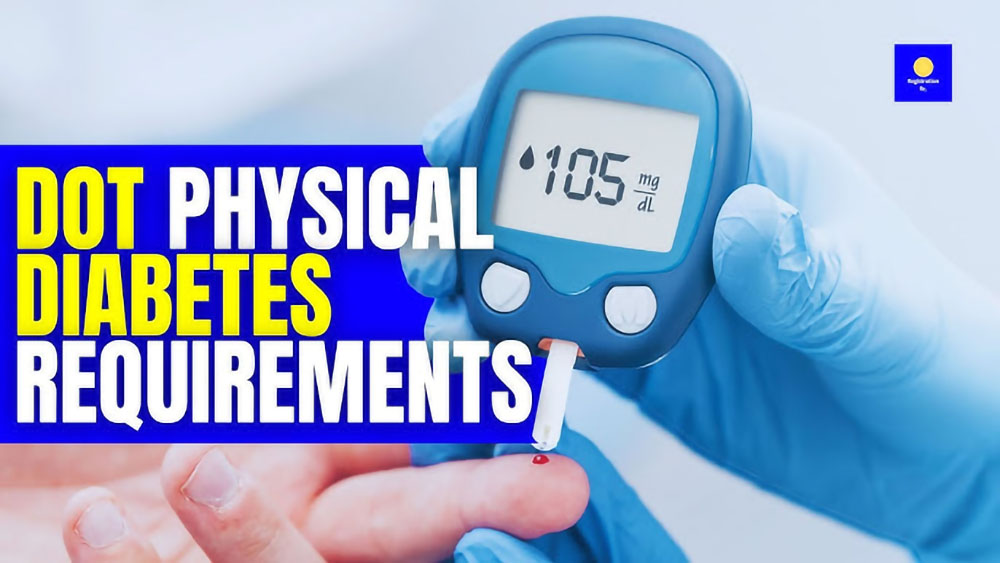For commercial drivers with diabetes, navigating the Department of Transportation (DOT) physical exam process can be challenging.
This comprehensive guide will explore the intricacies of diabetes management in relation to DOT physical exams, including recent regulatory changes, preparation strategies, and what to expect during your DOT medical exam.
Whether you’re preparing for a DOT medical exam in Nassau County or anywhere else in the United States, this information will help you understand the process and requirements.
Understanding Diabetes and Its Impact on Commercial Driving
Diabetes is a chronic condition that affects how your body processes glucose (sugar). There are two main types:
- Type 1 Diabetes: The body doesn’t produce insulin, requiring daily insulin injections.
- Type 2 Diabetes: The body doesn’t use insulin properly, often managed with diet, exercise, and medication.
For commercial drivers, diabetes can pose unique challenges due to the potential for sudden changes in blood sugar levels, which could affect driving performance and safety.
Historical Context: Diabetes and DOT Regulations
Historically, insulin-dependent diabetics were prohibited from operating commercial motor vehicles (CMVs) in interstate commerce.
This changed in 2003 when the Federal Motor Carrier Safety Administration (FMCSA) implemented a diabetes exemption program, allowing some insulin-treated diabetics to drive commercially if they met specific criteria.
Recent Changes in DOT Regulations for Diabetic Drivers
In November 2018, the FMCSA made significant changes to the regulations regarding insulin-treated diabetes mellitus (ITDM). These changes have made it easier for many diabetic drivers to maintain their commercial driving careers.
Key Changes:
- Elimination of the diabetes exemption program
- Allowing certified medical examiners to grant up to 12-month certifications to drivers with ITDM
- Requirement for annual or more frequent examinations by the driver’s treating clinician
Current DOT Physical Exam Requirements for Diabetic Drivers

Under the current regulations, drivers with diabetes must meet the following requirements:
For Insulin-Treated Diabetes:
- Medical Examination: Undergo a DOT physical exam by a certified medical examiner.
- Treating Clinician Evaluation: Provide a form (MCSA-5870) completed by the treating clinician who manages and prescribes insulin.
- Blood Glucose Logs: Maintain at least 3 months of blood glucose self-monitoring records.
- Stable Insulin Regimen: Be on a stable insulin regimen for at least 1 month.
- No Recent Severe Hypoglycemic Episodes: Have had no severe hypoglycemic episodes in the last 3 months.
For Non-Insulin-Treated Diabetes:
- Medical Examination: Undergo a standard DOT physical exam.
- Blood Sugar Control: Demonstrate adequate control of blood sugar levels.
- No Disqualifying Complications: Have no diabetes-related complications that would impair driving ability.
Preparing for Your DOT Medical Exam with Diabetes
If you’re a driver with diabetes preparing for a DOT medical exam in Elmont or elsewhere, consider the following steps:
1. Gather Necessary Documentation
- Recent lab results (A1C, lipid panel)
- List of all medications
- Blood glucose logs (at least 3 months)
- MCSA-5870 form completed by your treating clinician (for insulin-treated diabetes)
- Documentation of any diabetes-related complications or treatments
2. Manage Your Diabetes Effectively
- Maintain good blood sugar control
- Follow your prescribed treatment plan consistently
- Monitor and record your blood glucose levels regularly
- Be prepared to demonstrate your ability to manage your condition
3. Understand the Examination Process
During your DOT medical exam, the certified medical examiner will:
- Review your medical history and documentation
- Perform a physical examination
- Assess your ability to safely perform job duties
- Evaluate your understanding of diabetes management
- Determine if you meet the medical standards for certification
Potential Outcomes of the DOT Physical Exam

After your DOT medical exam, there are several possible outcomes:
1. Full Certification
If you meet all the medical standards, you may receive a medical examiner’s certificate valid for up to 12 months.
2. Conditional Certification
In some cases, the examiner may issue a certificate for less than 12 months, requiring more frequent monitoring.
3. Temporary Disqualification
If you have a condition that can be resolved or controlled, you may be temporarily disqualified until you can meet the standards.
4. Permanent Disqualification
In rare cases where diabetes has led to severe complications that impact safe driving, you may be permanently disqualified.
Managing Diabetes for Long-Term Commercial Driving Success
To maintain your commercial driving career with diabetes:
- Adhere to your treatment plan and medication regimen
- Monitor your blood glucose levels regularly
- Maintain a healthy lifestyle with proper diet and exercise
- Attend all scheduled medical appointments
- Stay informed about DOT regulations and any changes that may affect you
- Communicate openly with your healthcare providers and certified medical examiner
Conclusion
While diabetes can present challenges for commercial drivers, recent regulatory changes have made it easier for well-managed diabetics to maintain their careers.
By understanding the requirements, preparing thoroughly for your DOT medical exam, and effectively managing your condition, you can continue to drive safely and professionally.
Remember, whether you’re seeking a DOT medical exam in Elmont or any other location, the key to success lies in proactive management of your health and open communication with your healthcare providers and certified medical examiners.
With proper care and attention to the regulatory requirements, diabetes doesn’t have to be a roadblock to your commercial driving career.
